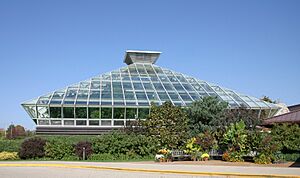Olbrich Botanical Gardens facts for kids
Olbrich Botanical Gardens is a wonderful place to visit in Madison, Wisconsin. It's named after its founder, Michael Olbrich. The gardens are managed by the City of Madison Parks and the Olbrich Botanical Society. They first opened in 1952. The gardens cover 16 acres of outdoor space. They also have a large 10,000-square-foot conservatory.
A special part of the gardens is the Bolz Conservatory, added in 1991. Another unique feature is the Sala Thai. This beautiful building was a gift from the Thai people and their king, Bhumibol Adulyadej. It opened in 2002. This sala is one of only four outside of Thailand. It is also one of only two in the United States. The other one is in Hawaii.
Contents
Exploring the Outdoor Gardens
The Olbrich Botanical Gardens have many different areas to explore. Each garden has its own special style.
The Sunken Garden
The Sunken Garden looks like a traditional English garden. It is surrounded by limestone walls and hedges. This garden has an 80-foot long reflecting pool. The pool helps connect the garden to nearby Lake Monona.
The Thai Garden
The Thai Garden is home to the special sala. A 155-foot arched footbridge crosses Starkweather Creek to reach it. This garden has a shallow reflecting pool near the pavilion. You can also see small Thai sculptures here. The plants in this garden look tropical in summer. They are also tough enough to survive Wisconsin winters.
The Rock Garden
The Rock Garden is built like a rocky hill. It looks like a mountain slope. Most plants here are conifers or alpine plants. Two streams flow through the garden. They create a waterfall and a small pond. A wooden footbridge crosses one of the streams.
Meadow and Wildflower Gardens
The Meadow Garden mixes perennial grasses, wildflowers, and plants grown from bulbs. The grass in this meadow is cut only once or twice a year. The small Wildflower Garden has many native plants. These include wildflowers, ferns, berries, trees, and shrubs.
Herb and Perennial Gardens
The Herb Garden has smaller sections of herbs. These sections are grouped by how the herbs are used. You can find medicinal herbs, dye herbs, and kitchen herbs. There are also 'touch' and 'smell' gardens. The Perennial Garden shows off many different perennials. It also has three ponds with a waterfall. Aquatic plants grow in these ponds.
The Rose Garden
The Rose Garden is always growing and changing. It features over 700 types of roses. There are 125 different rose cultivars. These include hybrid teas, floribundas, grandifloras, and hardy shrub roses.
Shade Gardens
The Starkweather Creek and Atrium Shade Gardens have a semicircular atrium. Plants like astilbes, hostas, lungwort, bishops' caps, and ferns grow here. The Eunice Fisher Hosta Garden is special. It features hostas hybridized by Eunice Fisher, who was from Wisconsin.
Discovering the Bolz Conservatory
The Bolz Conservatory is a huge greenhouse. It covers 10,000 square feet. This glass pyramid is 100 by 100 feet wide. It rises 50 feet high at its peak. Inside, you will find over 750 plants. These plants come from over 70 different families. There are more than 550 unique plant species and types. Most of these plants are from tropical and sub-tropical areas.
The temperature inside is kept between 65 and 80 degrees fahrenheit (18 to 26 °C). On sunny summer days, it can get up to 100°F (35 °C). The air is kept very moist, usually 70% humidity or higher.
Animals in the Conservatory
Besides plants, the conservatory is home to many species of birds. You might see canaries, waxbills, diamond doves, Goldian finches, and owl finches. There is also a koi pond. This pond is filled with colorful koi and goldfish. You might also spot frogs, toads, and geckos living among the plants.
While visiting the outdoor Olbrich Botanical Gardens is free, there is a small fee to enter the Bolz Conservatory.
Gallery
Images for kids
-
Pachira aquatica (Guyana chestnut) in the Conservatory
See also
 In Spanish: Jardín botánico Olbrich para niños
In Spanish: Jardín botánico Olbrich para niños











